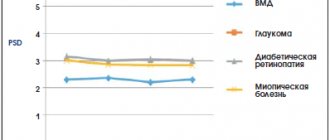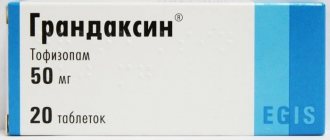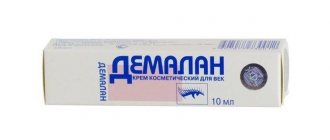| Composition and release form How the drug works When prescribed (indications) How to use (dosage) Contraindications for use Side effects of use | Overdose symptoms Drug interactions What to pay attention to Xalacom's analogs Prices in pharmacies Reviews from people who have used it |
Xalacom is a combined solution of antiglaucoma eye drops. It is used in ophthalmological practice for the treatment of intraocular hypertension, as well as open-angle glaucoma.
pharmachologic effect
Xalacom is a combined solution of eye drops that includes 2 active ingredients: latanoprost and timolol.
Latanoprost, as an analogue of prostaglandin F2a, has the ability to reduce IOP levels by activating the outflow of aqueous humor (increasing uvescleral outflow), which has an antiglaucoma effect. The effect of latanoprost on the production of intraocular fluid has not been reliably identified. Its ability to influence the blood-ophthalmic barrier has not been identified.
The second substance, timolol, being a non-selective beta-blocker, may have a slight sympathomimetic and membrane-stabilizing effect. When used topically, it lowers intraocular pressure by suppressing the production of aqueous humor and slightly increasing its outflow.
Interactions
With the simultaneous use of systemic beta blockers, slow calcium channel inhibitors, glycosides, antiarrhythmics, guanedine, the effects may be enhanced (hypotension, bradycardia, bronchospasm).
With the simultaneous use of two prostaglandin analogues, a paradoxical reaction (intraocular hypertension) is observed.
When combining the drug with epinephrine, mydriasis may develop.
With the simultaneous use of CYP2D6 inhibitors (paroxetine, quinidine, fluoxetine), the beta-blocking effect of the drug is enhanced.
Contraindications
- Individual hypersensitivity;
- Bronchial asthma and COPD;
- Severe cardiac dysfunction (chronic heart failure, atrioventricular block, sinus bradycardia, cardiogenic shock);
- Age up to 18 years;
- Pregnancy, lactation.
- Xalacom solution is prescribed with caution for inflammatory, congenital, neovascular, pigmentary, angle-closure glaucoma; open-angle glaucoma with pseudophakia; with aphakia, pseudophakia, rupture of the posterior lens capsule; patients at risk of macular edema.
Special instructions for the use of the drug Xalacom
To date, there is no data on the use of the drug in inflammatory eye diseases, inflammatory, neovascular, angle-closure and congenital glaucoma; There is little experience with the use of the drug in open-angle glaucoma in patients with pseudophakia, as well as in pigmentary glaucoma. Therefore, in these conditions, Xalacom is recommended to be used with caution. The drug has no or insignificant effect on the pupil, however, there is no data on the effect of the drug during an acute attack of angle-closure glaucoma, so the drug should be used with caution in this disease. Xalacom contains benzalkonium chloride, which can be absorbed by contact lenses. Therefore, before instilling eye drops, contact lenses should be removed; They can be inserted only 15 minutes after instillation. As with other topical ophthalmic medications, instilling eye drops may cause a temporary blurred vision to appear before the eyes.
Side effects
- Blepharitis, cataracts, conjunctivitis, visual impairment, allergic reactions (follicles, pinpoint hemorrhages), conjunctival reactions, pathological changes in the cornea (pigmentation, pinpoint keratitis, erosions), refractive changes, redness, pain, iris pigmentation, photophobia, ptosis, field loss vision, keratitis, decreased sensitivity of the cornea, diplopia.
- Disturbance of cerebral blood supply.
- Dry mouth, dyspepsia, nausea, diarrhea, retroperitoneal fibrosis.
- Sinusitis, upper respiratory tract infections, shortness of breath, bronchospasm.
- Hypercholesterolemia, diabetes mellitus.
- Angioedema, anaphylaxis, generalized rash, urticaria.
- Confusion, headache, dizziness, depression.
- Increase or decrease in blood pressure.
- Impotence, Peyronie's disease.
- Increased number of eyelashes, rash, chalazion.
- Arthritis, joint pain, muscle pain.
- Intermittent claudication, Raynaud's syndrome.
Drug interactions Xalacom
There is the possibility of an additive effect, which can cause arterial hypotension and/or severe bradycardia if eye drops with timolol are used simultaneously with calcium channel blockers, drugs that reduce the activity of catecholamines; β-adrenergic receptor blockers, as well as together with antiarrhythmic drugs (including amiodarone and quinidine), cardiac glycosides from the digitalis group, cholinomimetics, narcotic analgesics and MAO inhibitors. Topical use of two β-adrenergic blockers or two prostaglandin drugs is not recommended. Although Xalacom has little or no effect on pupil size when used as monotherapy, cases of mydriasis have occasionally been reported when the drug is used with epinephrine. β-adrenergic receptor blockers may enhance the hypoglycemic effect of antidiabetic agents.
special instructions
Patients should be warned about a possible change in the color of the iris when treated with Xalac solution and an increase in the number and length of eyelash hair. This is especially important when prescribing the drug to only one eye.
Xalacom solution contains benzalkonium chloride, a preservative that can be absorbed by hydrophilic soft contact lenses. This can subsequently damage the tissues of the eye. Therefore, before instilling the Xalac solution, contact lenses must be removed. You can install them after the procedure by waiting 15 minutes.
Instillation of Xalac solution often causes transient visual impairment. Until it is restored, it is better to stop driving a car and working with moving machinery.
Store Xalacom solution in a dark place at a temperature of 2° - 8°C. Not given to children.
Shelf life – 2 years. The solution is good for 4 weeks after opening the bottle.
Xalacom, 1 piece, 2.5 ml, eye drops
Xalacom® should be used no more than once a day, since more frequent administration of latanoprost leads to a weakening of the IOP-lowering effect.
If one dose is missed, the next dose should be administered at the usual time.
If the patient is using other eye drops at the same time, they should be used at least 5 minutes apart.
Xalacom® contains benzalkonium chloride, which can be absorbed by contact lenses. Before instilling drops, contact lenses must be removed and reinserted after 15 minutes.
Latanoprost.
May cause a gradual increase in the amount of brown pigment in the iris. The change in eye color is caused by an increase in the melanin content in the stromal melanocytes of the iris, and not by an increase in the number of melanocytes themselves. In typical cases, brown pigmentation appears around the pupil and extends concentrically to the periphery of the iris. In this case, the entire iris or parts of it become brown. In most cases, the color change is minor and may not be clinically detectable. Increased pigmentation of the iris of one or both eyes is observed mainly in patients with mixed iris color, containing a brown color as a base. The drug has no effect on nevi and lentigines of the iris; no accumulation of pigment in the trabecular meshwork or in the anterior chamber of the eye was noted.
When determining the degree of pigmentation of the iris for more than 5 years, no undesirable consequences of increased pigmentation were revealed, even with continued therapy with latanoprost. In patients, the degree of IOP reduction was the same, regardless of the presence or absence of increased iris pigmentation. Therefore, treatment with latanoprost can be continued in cases of increased pigmentation of the iris. Such patients should be monitored regularly and, depending on the clinical situation, treatment may be discontinued.
Increased pigmentation of the iris is usually observed during the first year after the start of treatment, rarely during the second or third year. After the fourth year of treatment, this effect was not observed. The rate of pigmentation progression decreases over time and stabilizes after 5 years. In the longer term, the effects of increased iris pigmentation have not been studied. After stopping treatment, no increase in brown pigmentation of the iris was noted, but the change in eye color may be irreversible.
In connection with the use of latanoprost, cases of darkening of the skin of the eyelids have been described, which may be reversible.
Latanoprost may cause gradual changes in eyelashes and vellus hairs, such as lengthening, thickening, increased pigmentation, increased thickness, and a change in the direction of eyelash growth. Changes in eyelashes are reversible and disappear after cessation of treatment.
Patients using drops in only one eye may develop heterochromia.
Timolol maleate
When beta-blockers are used topically, the same adverse reactions may occur as when they are used systemically. Patients with a history of severe heart disease should be closely monitored for early detection of symptoms of heart failure. With local use of timolol maleate, the following reactions from the heart and respiratory system may occur: progression of Prinzmetal's angina, as well as peripheral and central circulatory disorders, hypotension, fatal heart failure, severe reactions from the respiratory system, incl. bronchospasm with fatal outcome in patients with asthma, bradycardia.
Before undergoing major surgery, the advisability of gradual withdrawal of beta-blockers should be discussed. Drugs in this group impair the heart's ability to respond to reflex beta-adrenergic stimulation, which may increase the risk during general anesthesia. Cases of prolonged severe hypotension during anesthesia and difficulties in restoring and maintaining cardiac contractions have been described. During surgery, the effects of beta-blockers can be reversed by sufficient doses of adrenergic agonists.
Beta-blockers can enhance the hypoglycemic effect of antidiabetic agents and mask the symptoms and manifestations of hypoglycemia. They should be used with caution in patients with spontaneous hypoglycemia or diabetes (especially labile diabetes) receiving insulin or oral hypoglycemic agents.
Beta blocker therapy may mask some of the underlying symptoms and manifestations of hyperthyroidism. Abrupt cessation of treatment may cause an exacerbation of this disease.
When treated with beta-blockers in patients with atopy or a history of severe anaphylactic reactions to various allergens, the response may be enhanced upon repeated contact with these allergens. In this case, adrenaline in normal doses used to relieve anaphylactic reactions may be ineffective.
In rare cases, timolol maleate has caused increased muscle weakness in patients with myasthenia gravis
or myasthenic symptoms (eg, diplopia, ptosis, generalized weakness).
When using IOP-lowering agents, choroidal detachment after filtration procedures has been described.
Influence on the ability to drive a car and other mechanisms.
The use of eye drops may cause transient blurred vision. Until this effect goes away, patients should not drive or use complex machinery.
Xalacom overdose, symptoms and treatment
Apart from eye irritation and conjunctival hyperemia, no other ocular or systemic side effects have been identified following an overdose of latanoprost. An overdose of timolol is characterized by the following symptoms: bradycardia, arterial hypotension, bronchospasm and cardiac arrest. If the above symptoms occur, symptomatic and supportive therapy is indicated. Tests have shown that timolol is poorly excreted during hemodialysis. If latanoprost is accidentally ingested, it must be taken into account that it undergoes extensive metabolism on its first pass through the liver.








